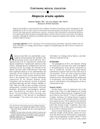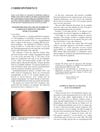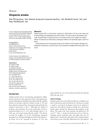Alopecia Areata in Children
TLDR Alopecia areata in children is often linked to genetics, autoimmune issues, and stress, and is treated with corticoids or PUVA therapy.
Alopecia areata in children was a condition characterized by hair loss, accounting for 2-5% of dermatological consultations in this age group. Its etiology was believed to be multifactorial, involving genetic predisposition and autoimmune disorders, with associations to diseases like type 1 diabetes, Hashimoto's thyroiditis, pernicious anemia, and Addison's anemia, as well as emotional stress. Clinically, it presented as round or oval patches of hair loss, primarily on the head, without inflammation. Diagnosis was aided by the presence of short hairs with thin proximal ends at the plaque periphery. Treatment varied with disease severity, commonly using corticosteroids, and alternatives like PUVA therapy, which combined psoralens with UVA irradiation. Psychological support was sometimes necessary.




